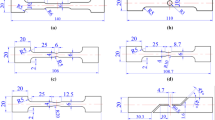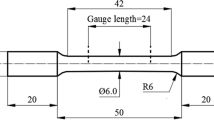Abstract
During the metal forming process, the avoidance of ductile fracture has been of great interest to the scientific and engineering communities over the past decades. Hence, ductile damage prediction remains a key issue for achieving defect-free products. In this paper, the elastoplastic damage behaviour of DC04 steel has been studied and simulated to predict the fracture during the deep drawing process and reduce the industrial trial cost. In this context, a fully coupled elastoplastic damage model has been developed and implemented in the Abaqus explicit code using the VUMAT subroutine, knowing that the used elastoplastic and the damage parameters were identified by experimental tests. Numerical simulations have been performed to validate this model, followed by comparisons with the experimental results. These comparisons show a good correlation between the experimental and simulation results and good agreement with the empirical observations. Thus, the initiation of damage and its evolution leading to ductile fracture can be predicted using this model.

















Similar content being viewed by others
References
Ahmetoglu M, Broek TR, Kinzel G, Altan T (1995) Control of blank holder force to eliminate wrinkling and fracture in deep-drawing rectangular parts. CIRP Annals 44(1):247–250. https://doi.org/10.1016/S0007-8506(07)62318-X
Manabe K, Koyama H, Yoshihara S, Yagami T (2002) Development of a combination punch speed and blank-holder fuzzy control system for the deep-drawing process. J Mater Process Technol 125:440–445. https://doi.org/10.1016/S0924-0136(02)00363-1
Yi S, Bohlen J, Heinemann F, Letzig D (2010) Mechanical anisotropy and deep drawing behaviour of AZ31 and ZE10 magnesium alloy sheets. Acta Mater 58(2):592–605. https://doi.org/10.1016/j.actamat.2009.09.038
Modi B, Kumar DR (2013) Development of a hydroforming setup for deep drawing of square cups with variable blank holding force technique. The Int J Adv Manuf Technol 66(5):1159–1169. https://doi.org/10.1007/s00170-012-4397-4
Ma W, Wang BY, Lei Fu, Jing Zhou, Huang MD. Effect of friction coefficient in deep drawing of AA6111 sheet at elevated temperatures. Transactions of Nonferrous Metals Society of China. 2015; 25(7): 2342–2351. https://doi.org/10.1016/S1003-6326(15)63849-3
Modi B, Kumar DR (2019) Optimization of process parameters to enhance formability of AA 5182 alloy in deep drawing of square cups by hydroforming. J Mech Sci Technol 33(11):5337–5346. https://doi.org/10.1007/s12206-019-1026-2
Preedawiphat P, Koowattanasuchat P, Mahayotsanun N, Mahabunphachai S (2020) Sheet thinning prediction method based on localized friction effect in deep-drawing. Adv Mech Eng 12(9):1–10. https://doi.org/10.1177/1687814020953941
Lemaitre J (2012) A course on damage mechanics. Springer Science & Business Media
İpekoğlu G, Çam G (2019) Formation of weld defects in cold metal transfer arc welded 7075–T6 plates and its effect on joint performance. IOP Conf Ser Mater Sci Eng 629(1):012007. https://doi.org/10.1088/1757-899X/629/1/012007
Çam G, Koçak M (2007) Microstructural and mechanical characterization of electron beam welded Al-alloy 7020. J Mater Sci 42:7154–7161. https://doi.org/10.1007/s10853-007-1604-z
Çam G, Koçak M, Dobi D, Heikinheimo L, Siren M (1997) Fracture behaviour of diffusion bonded bimaterial Ti–Al joints. Sci Technol Weld Joining 2(3):95–101. https://doi.org/10.1179/stw.1997.2.3.95
Gurson AL (1977) Continuum theory of ductile rupture by void nucleation and growth: part I—yield criteria and flow rules for porous ductile media. J Eng Mater Technol 99(1):2–15. https://doi.org/10.1115/1.3443401
Tvergaard V (1982) On localization in ductile materials containing spherical voids. Int J Fract 18(4):237–252. https://doi.org/10.1007/BF00015686
Tvergaard V (1982) Ductile fracture by cavity nucleation between larger voids. J Mech Phys Solids 30(4):265–286. https://doi.org/10.1016/0022-5096(82)90033-3
Needleman A, Tvergaard VF (1984) An analysis of ductile rupture in notched bars. J Mech Phys Solids 32(6):461–490. https://doi.org/10.1016/0022-5096(84)90031-0
Kachanov LM (1958) Time of the rupture process under creep conditions. Izvestiia Akademii Nauk SSR (Otdelenii Techniceskih Nauk) 8:26–31
Chaboche JL (1984) Anisotropic creep damage in the framework of continuum damage mechanics. Nucl Eng Des 79(3):309–319. https://doi.org/10.1016/0029-5493(84)90046-3
Lemaitre J (1985) A continuous damage mechanics model for ductile fracture. J Eng Mater Technol 107(1):83–89. https://doi.org/10.1115/1.3225775
Lemaitre J (1985) Coupled elasto-plasticity and damage constitutive equations. Comput Methods Appl Mech Eng 51(1–3):31–49. https://doi.org/10.1016/0045-7825(85)90026-X
Cao TS (2017) Models for ductile damage and fracture prediction in cold bulk metal forming processes: a review. IntJ Mater Form 10(2):139–171. https://doi.org/10.1007/s12289-015-1262-7
Cai S, Chen L (2021) Parameter identification and blanking simulations of DP1000 and Al6082-T6 using Lemaitre damage model. Adv Manuf 9(3):457–472. https://doi.org/10.1007/s40436-021-00350-5
Kumar P, Tandon P (2022) Investigating the capability of the Lemaitre damage model to establish the incremental sheet forming process. Arch Civil Mech Eng 22(2):1–18. https://doi.org/10.1007/s43452-022-00391-y
Wang C, Daniel WJT, Lu H, Liu S, Meehan PA (2021) A comparative investigation of damage models for fracture prediction in two-point incremental forming. Int J Adv Manuf Technol 112(11):3069–3081. https://doi.org/10.1007/s00170-020-06587-x
Fan JP, Tang CY, Tsui CP, Chan LC, Lee TC (2006) 3D finite element simulation of deep drawing with damage development. Int J Machine Tools Manuf 46(9):1035–1044. https://doi.org/10.1016/j.ijmachtools.2005.07.044
Khelifa M, Oudjene M, Khennane A (2007) Fracture in sheet metal forming: effect of ductile damage evolution. Comput Struct 85(3–4):205–212. https://doi.org/10.1016/j.jmatprotec.2007.08.041
Saxena RK, Gautam SS, Dixit PM (2010) Numerical simulation of fracture in cup drawing. IntJ Mater Form 3(1):117–120. https://doi.org/10.1016/j.finel.2011.04.003
Amaral R, Teixeira P, Santos AD, de Sá JC (2018) Assessment of different ductile damage models and experimental validation. IntJ Mater Form 11(3):435–444. https://doi.org/10.1007/s12289-017-1381-4
Chalal H, Abed-Meraim F (2017) Numerical predictions of the occurrence of necking in deep drawing processes. Metals 7(11):455. https://doi.org/10.3390/met7110455
Boussaid O, Bourgeois N, Martiny M, Ferron G, Chaoui K (2008) Experimental characterization of mild steel in deep drawing. Int Rev Mech Eng 2(4):632–637
Ghennai W, Boussaid O, Bendjama H, Haddag B, Nouari M (2019) Experimental and numerical study of DC04 sheet metal behaviour—plastic anisotropy identification and application to deep drawing. Int J Adv Manuf Technol 100(1):361–371. https://doi.org/10.1007/s00170-018-2700-8
Ghennai W, Boussaid O, Bendjama H, Guersi N (2019) Pressure and friction effects on the mechanical behaviour of a ductile material during deep drawing. In Int J Eng Res Africa Trans Tech Publications Ltd 41:8–19.https://doi.org/10.4028/www.scientific.net/JERA.41.8
Von-Mises R (1913) Mechanik der festen Körper im plastischdeformablen Zustand. Nachrichten von der Gesellschaft der Wissenschaften zu Göttingen, Mathematisch-Physikalische Klasse. 582–592
Lee SW, Pourboghrat F (2005) A simulation for the punchless piercing process using lemaitre damage model. In AIP Conf Proc Am Inst Physics 778(1):505–510. https://doi.org/10.1016/j.ijmecsci.2005.06.009
Swift HW (1952) Plastic instability under plane stress. J Mech Phys Solids 1(1):1–18. https://doi.org/10.1016/0022-5096(52)90002-1
Acknowledgements
The authors would like to thank the Industrial Vehicles Company (SNVI VIR) in Rouiba, Algiers, Algeria, for giving us the opportunity to do an internship there and providing us with the used material for the study.
Author information
Authors and Affiliations
Contributions
All authors contributed to the study’s conception and design. Material preparation, data collection, and analysis were performed by [Salah LABOUBI], [Ouzine BOUSSAID], [Mohamed ZAAF], and [Walid GHENNAI].
Corresponding author
Ethics declarations
Consent for publication
The present work is a numerical investigation and experimental validation of the Lemaitre ductile damage model for DC04 steel and application to the deep drawing process. I certify that the submission is original. The manuscript has not been previously published, is not currently submitted for review to any other journal, and will not be submitted elsewhere before a decision is made by this journal.
Conflict of interest
The authors declare no competing interests.
Additional information
Publisher's note
Springer Nature remains neutral with regard to jurisdictional claims in published maps and institutional affiliations.
Rights and permissions
Springer Nature or its licensor (e.g. a society or other partner) holds exclusive rights to this article under a publishing agreement with the author(s) or other rightsholder(s); author self-archiving of the accepted manuscript version of this article is solely governed by the terms of such publishing agreement and applicable law.
About this article
Cite this article
Laboubi, S., Boussaid, O., Zaaf, M. et al. Numerical investigation and experimental validation of Lemaitre ductile damage model for DC04 steel and application to deep drawing process. Int J Adv Manuf Technol 126, 2283–2294 (2023). https://doi.org/10.1007/s00170-023-11244-0
Received:
Accepted:
Published:
Issue Date:
DOI: https://doi.org/10.1007/s00170-023-11244-0




